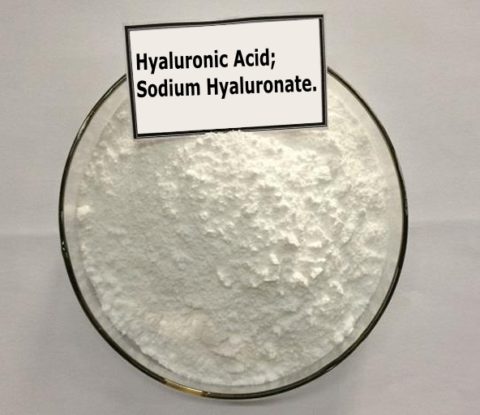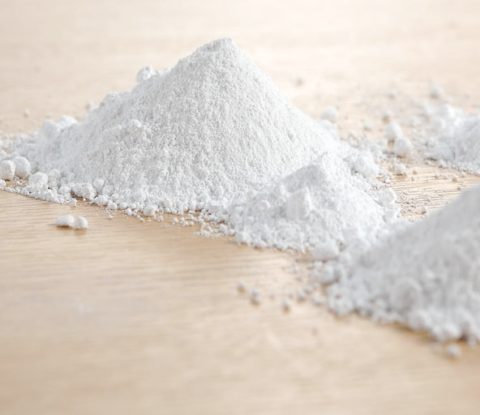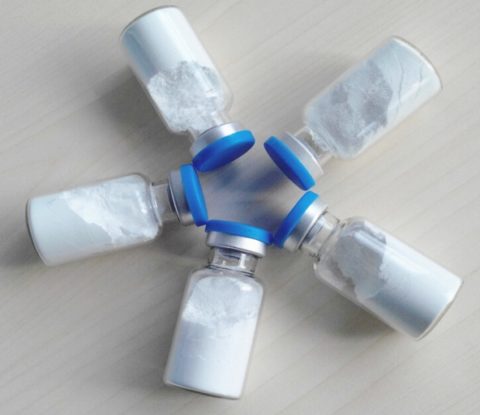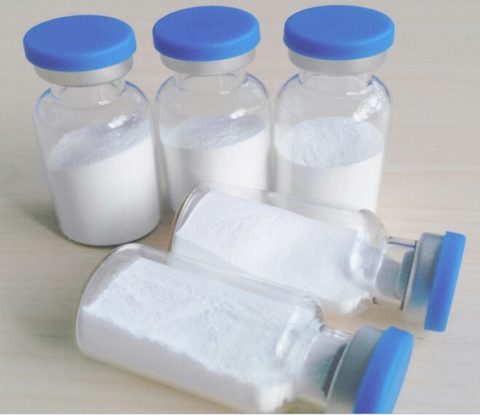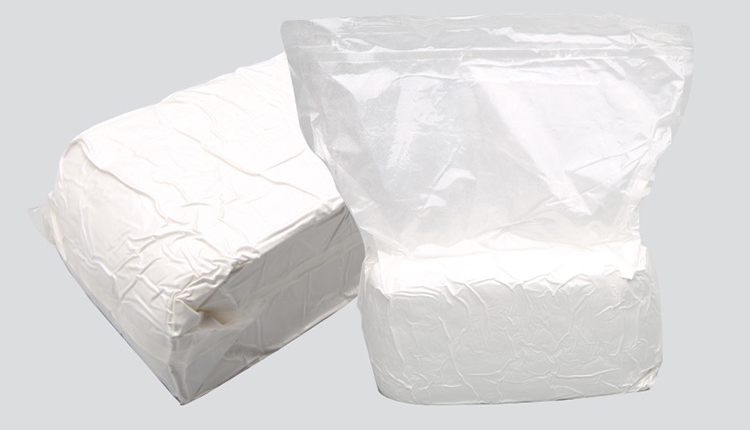
Hyaluronic Acid, Sodium Hyaluronate Powder(Food Grade&Cosmetic Grade )
Hyaluronic acid, unlike other mucopolysaccharides, does not contain sulfur. Its hyaluronic molecule can carry more than 500 times of water, which is the best moisturizing component recognized today, and widely used in maintenance products and cosmetics.
Hyaluronic Acid Powder(Sodium Hyaluronate)
【Other names】: hyaluronan, Sodium Hyaluronate
【Apperance】: White crystalline power
【Specification】: 91%; 95%
【CAS No. 】: 9004-61-9(hyaluronic acid), 9067-32-7(Sodium hyaluronate)
【Molecular Formula】: hyaluronic acid-(C14H21NO11)n, Sodium hyaluronate -(C14H20NO11Na)n
【Molecular Weight】:
| Grade | Molecular weight | Test method |
| Cosmetic grade | 2,000-5,000Da | Sulfuric acid carbazole |
| 8,000-15,000Da | ||
| 1.0-1.5*10,000,000 Da | ||
| 1.5-2.0*10,000,000 Da | ||
| 2.0-2.5*10,000,000 Da | ||
| Food Grade | 8,000-15,000Da | |
| 40,000-50,000Da | ||
| 1.0-1.5*10,000,000 Da | ||
| Pharmaceutical Grade | Eye drops grade:
2.0-3.0*10,000,000 Da |
|
| Injection Grade: 2.0-3.0*10,000,000 Da Endotoxin≤0.5IU/MG |
In 1934, Karl Meyer isolated a formerly unknown glycosaminoglycan from the bovine vitreous. The glycosaminoglycans with non-sulphated has big difference with previously discovered one. Because this distinctive structure, it has a unique role in the human body. Karl Meyer called this substance is Sodium Hyaluronate, and followed by a further scientific research. At the time, this new substance has two names: Sodium Hyaluronate when referring to its endogenous synthesis, and Hyaluronic Acid when discussing research conducted on human body or animal. Today Sodium Hyaluronate is commonly referred to as Hyaluronic Acid in Practice.
Hyaluronic Acid/Sodium Hyaluronate is mucopolysaccharide-like substances, it’s a linear, unbranched, high molecular weight polysaccharides composed of disaccharide repeating unit (D- glucuronic acid and N-acetyl glucosamine). HA, in its natural state, the average molecular weight is around 10 5 -10 7 Da. Sodium Hyaluronate has a strong Viscoelasticity and excellent lubricity. The other glycosaminoglycans in the body include chondroitin sulfate, keratan sulfate, dermatan sulfate, heparin sulfate etc.
Hyaluronic Acid/Sodium Hyaluronate widely distributes in the extracellular spaces of animal tissues. Almost all kinds of animal tissues contain Sodium Hyaluronate more or less. So far HA has been isolated from skin, cockcomb, brain, vitreum, connective tissue, umbilical cord, human serum, articular fluid, gristle, human urine, cock embryo, oocyte, artery, vein etc.
LMW Grade Hyaluronic Acid/Sodium Hyaluronate
Sodium Hyaluronate (Hyaluronic Acid) is a mocopolysaccharide composed of repeated disaccharide units of Nacetylglucosamine and glucuronic acid. The commercial Hyaluronic Acid is commonly a sodium form, called sodium hyaluronate. HA is widely presents in the extracellular matrix of amimal tissues and vitreous humor . Its main physiological function is water retention and lubrication. Low molecular weight sodium hyaluronate (LMWHA) can penetrate dermis to be absorbed easily by the skin. By improving blood circulation, regulating skin metabolism and ameliorating skin nutrition, LMWHA can prevent the skin aging and maintain the collagen function. LMWHA is particularly useful in beauty parlors because of its character of penetrating dermis easily . Imported by skin conditioners with the assistance of low voltage impulse or heat, LMWHA can improve the generation of new cells and resist againg so as to let skin feel its true value. HA in human body is high molecular weight substance. LMWHA can be synthesized into HMWHA after being absorbed by body, so the amount of entogenous Hyaluronic Acid increases. The nourishing of LMWHA acts on the whole body from the dermis to the epidermis.
Pharmaceutical Grade Hyaluronic Acid/Sodium Hyaluronate
Hyaluronic Acid is major components in human stromal cells, vitreous, synovial fluid and other connective tissue in the body HA plays an important role in retaining water, maintain extracellular space, adjusting osmotic pressure, lubricating and improving cells reparation. Sodium Hyaluronate molecule contains a large number of hydroxyl groups ,in can form hydrogen bonds intra-molecular and inter-molecular in aqueous solution, which offers a powerful water retention function to combine more than 400 times volumn water . At relatively higher concentration, its aqueous solution has remarkable viscoelasticity due to the complicated third-class reticular structure formed through the interaction of molecules. As a major components of intercellular substance, HA directly takes part in electrolyte alternate controlbetween cells and exerts the function of message filter of physics and molecule. High molecular HA can restrain the movement, multiplication and phagocytosis of cells while low molecular HA plays a role of stimulation.
Hyaluronic Acid has unique physicochemical properties and physiological functions. It has been widely applied in the pharmaceutical industry. HA can be used as viscoelastic materials in intraocular lens implantation and as fillers in articular surgery against osteoarthritis, rheumatoid arthritis etc. It is also used as medium in eye drops extensively. Furthermore, HA is helpful in preventing post-surgery conglutination and improving wound healing. The compound as a result of its reaction to other medicine may play a role of sustained release, thus achieving the purpose of targeted and timed release. With the development of medical science, HA will become more and more useful in the field of medicine.
Cosmetic Grade Hyaluronic Acid/Sodium Hyaluronate
Hyaluronic Acid is a natural biotic component widely presents in skin and other tissues. It has outstanding moisturizing effect, thus called Natural Moisturizing Factor (NMF) in the world. HA is the best component used in cosmetics for moisturizing from the nature.
When it is applied to skin, macromolecular Hyaluronic Acid can form a thin layer permeable to air, keeping the skin smooth and moist and further protecting it from bacteria, dust and ultraviolet rays, while micromolecular HA can penetrat into corium, enlarging blood capillaries slightly, promoting blood circulation, improving intermediary metabolism and nourishment-absorbing ability of skin, thus eliminating wrinkles, increasing skin’s elasticity and delaying its aging. In addition, HA can further hyperplasia of epidermic cell, clean oxygen-derived free radicals, prevent and rehabilitate skin injuries. Its aqueous solution has very high viscosity which can make water become thicker. Cream made by emulsifying HA with oil is fine and even, homogeneous with stable emulsifiction.
Hyaluronic Acid is the best natural moisturizing component used in high-end cosmetics. Thanks to it’s good compatibility, HA can be added to almost any beauty cosmetics, such as cream, lotion, astringent, essence, facial cleanser, shower gel, shampoo, hair conditioner, mousse and lip stick. In most cases, the dosage is around 0.05%-0.5%.
Food Grade Hyaluronic Acid/Sodium Hyaluronate
The body in embryonic period has the highest Hyaluronic Acid content, but it gradually reduced after birth. HA content varies with each individual even among the crowd of the same age. Reduction of HA content will directly lead to skin ageing and functional decaying. For example, HA content significantly reduced in the progeria patients. There is still many limitations for the external use of HA on skin , which can only work as lubrication and water retention.. However, the oral use of HA can increase endogenetic HA level through digestion and absorption, which makes skin moist, glossy and elastic.
Hyaluronic Acid also plays an important role of water retention and lubrication in other tissues and organs, such as joint cavity, blood vessel, heart and brain. Decrease of HA level of these tissues can result in arthritis, arteriosclerosis, pulse disorder and brain atrophy . Oral HA can restore the normal content of HA in body and delay apolexis and make the body energetic. At present, HA is widely applied to health and beauty products in the developed countries, such as America, Japan and Europe. It is greatly welcomed by the consumers.
Physiological Functions
Hyaluronic Acid/Sodium Hyaluronate is a major component of intercellular substances, and also
distributed widely in other tissues to play an important physiological role, such as:
1. Wounds healing.
2. Anti-sunbum and repair of the injured skin.
3. Prevention of infection.
4. Regulation of electrolyte and water in extracellular fluid.
5. Lubrication.
6. Maintenance of stable transparent fluid in the eye.
Application of Hyaluronic Acid/Sodium Hyaluronate
Hyaluronic Acid/Sodium Hyaluronate has a wide range of molecular weight, from tens of thousands to millions of daltons. The use effect of Sodium Hyaluronate varies with its different molecular weight. For cosmetic purpose, the molecular weight is usually not more than 1. 5 million daltons.
1. For facial cleanser and liquid agent (such as skin toner and tender lotion): HA with a molecular weight of about 0.8 million doltons is recommended.
2. For cream, gel, skin emulsion and skin milk, HA with a molecular weight of 1-1.3 million doltons is recommended.
3.For eye care products like eye cream, HA with a molecular weight of 1.3-1.5 million doltons is recommended.
4. For effecacy-specific products like sun cream, additional dosage (>=0.1%) is recommended so as to fully exert the sustained release function of Sodium Hyaluronate, improve its efficacy and extend its shelf life.
